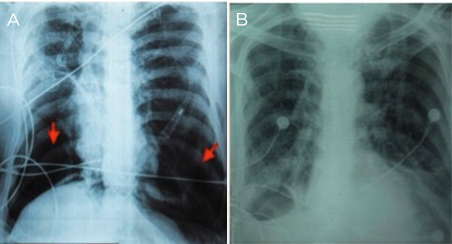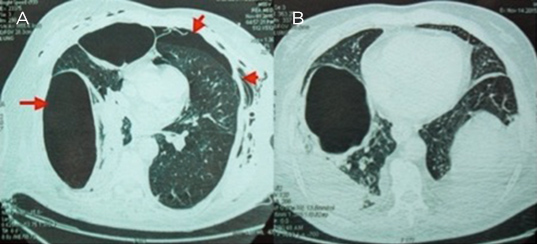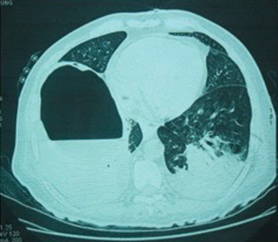ABSTRACT
Introduction: Pulmonary interstitial emphysema is a rare finding defined as abnormal air collection inside the lung interstitial tissues. Described more frequently in ventilated new-borns, pulmonary interstitial emphysema is an uncommon barotrauma-related complication in adults. Management and clinical sequelae are poorly described.
Patient: We describe the case of a 64-year-old man who presented with huge pulmonary interstitial emphysema together with simultaneous pulmonary barotrauma in status asthmaticus requiring invasive ventilation.
Discussion: There are no guidelines for the management of such complications and their possible sequelae but conservative treatment seems to be effective. The treatment of our patient is described.
LEARNING POINTS
- We describe ventilation-induced tension pulmonary interstitial emphysema combined with contralateral pneumothorax, pneumomediastinum, pneumoperitoneum and subcutaneous emphysema which developed immediately after difficult airway management of acutely decompensated asthma in an adult.
- The present case highlights the importance of crash induction, cautious airway management and protective re-ventilation in the management of acute respiratory failure with dynamic hyperinflation, such as status asthmaticus.
- Minimally invasive management by percutaneous trans-thoracic intrabullous chest-tube drainage is feasible, safe and relatively effective.
KEYWORDS
Pulmonary interstitial emphysema, status asthmaticus, barotrauma, mechanical ventilation
INTRODUCTION
The use of mechanical ventilation in acute asthma is closely associated with some life-threatening complications such as pneumothorax, pneumomediastinum, pneumoperitoneum and subcutaneous emphysema[1]. There are clear guidelines for the management of each of these complications. However, pulmonary interstitial emphysema is an extremely uncommon barotrauma-related condition in adults[2], so physicians have little experience in recognising and managing this complication.
CASE REPORT
A 64-year-old man presented with a 1-week history of episodes of progressively worsening shortness of breath with wheezing. He had a history of moderate persistent allergic asthma and a total resection of a mediastinal mass in December 2012. Twenty-four hours before his admission to the ICU, he presented to a primary hospital with status asthmaticus requiring invasive ventilation because of rapid patient fatigue with altered level of consciousness despite optimal therapy. The conditions surrounding intubation were reported to be difficult. The chest radiograph (Fig. 1a) showed left-sided pneumothorax and increased transparency of the right lung field mimicking contralateral pneumothorax. On admission to the ICU, the patient was asynchronized with the ventilator and required deep analgosedation and muscle paralysis agents. He was afebrile, with a heart rate of 130 beats/min and blood pressure of 70/40 mmHg. He presented subcutaneous emphysema localized in the chest, breast and neck. His breath sounds were distant on both sides with wheezes. Volume-controlled ventilation delivered a 1.0 fraction of inspired oxygen (FIO2), tidal volume of 6 ml/kg, respiratory rate of 12 and zero external PEEP. The highest peak inspiratory pressure was 70 cmH2O, while intrinsic positive end expiratory pressure (PEEPi) was 14 cmH2O. Arterial blood gas values were: pH, 7.2; PaCO2, 66 mmHg; and PaO2, 180 mmHg. The white blood cell count was 15,200/mm3; blood urea nitrogen, 14 mmol/l; serum creatinine, 178 µmol/l; and lactates, 3.2 mmol/l.
The chest CT scan showed a giant right perivascular and peribronchial emphysema consistent with pulmonary interstitial emphysema, an anterior left-sided pneumothorax, a pneumomediastinum, a non-compressive pneumoperitoneum and subcutaneous emphysema (Fig. 2a). Insertion of a chest tube on the left side allowed total lung re-expansion, improving oxygenation, and ventilatory and haemodynamic parameters. The patient was treated with fluid expansion, intravenous corticosteroids, β2-agonists and antibiotics. The pneumomediastinum and subcutaneous emphysema resolved spontaneously and the chest tube was withdrawn on day 12. During his ICU stay, the patient presented altered lung compliance, probably related to the right-sided huge compressive pulmonary interstitial emphysema. Watchful waiting was the therapeutic option initially adopted, leading to partial regression of the pulmonary interstitial emphysema documented on the chest CT scan on day 15 (Fig. 2b). The residual emphysema bullae were drained to improve an already compromised respiratory status associated with ventilatory weaning difficulties related to ICU-acquired weakness. Chest tube withdrawal after total regression was twice followed by recurrence and the development of sepsis due to a suppurative collection in the same sequelar basal emphysema bullae (Fig. 3).
Figure 1. (a) Chest x-ray at admission showing a left pneumothorax and basal right lung increased transparency.
(b) Chest x-ray at discharge showing a sequelar air-filled interstitial basal right-sided cyst.
Figure 2. (a) Chest CT scan showing giant right-sided perivascular peribronchial emphysema, anterior left-sided pneumothorax, pneumomediastinum and subcutaneous emphysema.
(b) Chest CT scan on day 15 showing residual emphysema bullae.
Figure 3. Chest CT scan showing a purulent collection in the sequelar basal emphysema bullae.
On each occasion, CT scan-guided chest drainage and intravenous antibiotics were required. Microbiological cultures were positive for endogenous anaerobic bacteria. The chest tube was finally withdrawn on day 62 leaving behind a localized persistent air-filled interstitial basal right-sided cyst (Fig. 1b). The patient was discharged from the ICU on day 72 under home ventilation.
Methods and Procedures
We searched PubMed using the keywords 'pulmonary interstitial emphysema', 'barotrauma', 'mechanical ventilation', 'asthma', 'adult' and 'treatment'. Our search revealed no articles. When we withdrew the key word 'asthma', the search identified 11 articles, most of which were case series published from 1979 to 2000. In most cases, acute respiratory distress syndrome (ARDS) was the most common pulmonary condition underlying pulmonary interstitial emphysema[2–7].
DISCUSSION
Pulmonary barotrauma is mainly mediated by non-physiological pressure differences between overdistended alveoli and the surrounding tissues and spaces. Although most often occurring in conjunction with ARDS, barotrauma can occur in ventilated patients with underlying diseases characterized by airflow obstruction and dynamic lung hyperinflation[1]. The clinical presentation can be asymptomatic or lead to respiratory distress usually following a large tension pneumothorax. Other presentations including pulmonary interstitial emphysema can occur alone or in combination[1]. The present patient, admitted for acute severe asthma, simultaneously developed five mechanical ventilation-induced barotrauma conditions: left-sided pneumothorax, contralateral tension pulmonary interstitial emphysema, pneumomediastinum, pneumoperitoneum and subcutaneous emphysema. Caused by the dissipation of air from the alveoli or the terminal bronchioles into the pulmonary interstitium, pulmonary interstitial emphysema is usually an iatrogenic pulmonary condition of the ventilated lungs of a premature newborn[2].
The large size of the emphysema in our case was another notable peculiarity[3,4]. The diagnosis of pulmonary interstitial emphysema based only on chest x-ray findings is difficult. A CT scan is necessary because it is more sensitive allowing ipsilateral pneumothorax to also be ruled out [3]. The self-expanding air leak process is maintained by mechanical ventilation, which may result in significant expansion over only few hours. Once formed, the air cysts create dead space by compressing adjacent normal lung tissue. In the present case, the escaped air created a giant pulmonary interstitial emphysema in a couple of hours. Gas exchange was initially compromised with a PaO2/FiO2 ratio below 200 for 1 week.
Interstitial air can spontaneously resolve, progress with further air-leak into adjacent space causing, for example, a secondary pneumothorax, or form diffused or localized persistent pulmonary interstitial emphysema in which infection is a reported complication[4]. The main treatments for new-borns are: lateral decubitus positioning, selective intubation or artificial pneumothorax[5,6]. Lobectomy and pneumonectomy are rarely used[7]. The choice between conservative or surgical management of pulmonary interstitial emphysema depends largely on the severity of the condition and the stability of the patient; there are no relevant guidelines. The present case was initially managed by lateral positioning under permissive hypercapnia ventilation leading to spontaneous partial resolution.
Subsequently, the patient was managed safely by chest drainage. CT scan-guided intracavitary drainage of suppurative collections under local anaesthesia was required twice after the first intra-bullae tube withdrawal.
In conclusion, pulmonary interstitial emphysema is a rare ventilatory support-related life-threatening side effect in an acutely ill adult with asthma. Its simultaneous occurrence with four other barotrauma pulmonary conditions is exceptional.
There are few reports on the management of this condition and its clinical sequelae in critically ill adult patients, and thus management and its timing is difficult. Early CT scan-guided intercostal tube thoracostomy could improve outcome and should be tried as a first-line treatment.


